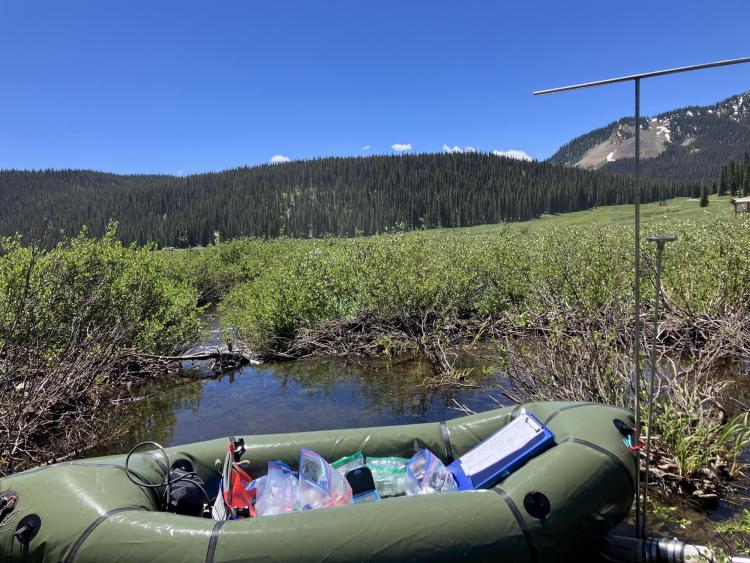Study suggests boosting beaver populations could have toxic consequences
Beavers are influential animals in ecosystems. These dam-building, tree-chewing rodents change streamflow with their wooden barriers and create rich wetland habitats by diverting water into soils near rivers. They help conserve water and improve biodiversity.
But a preliminary study by CU Boulder researchers suggests that beaver activities in the Western U.S. may exacerbate the spread of mercury-containing toxins in rivers and the surrounding habitats. Clifford Adamchak, a doctoral student in the Department of Ecology and Evolutionary Biology, and the Cooperative Institute for Research In Environmental Sciences (CIRES) presented the team’s findings at the 2023 meeting of the American Geophysical Union in San Francisco.
“In a world where beavers are increasingly being seen as an effective means to achieve various conservation and restoration goals, there is a possibility that we would see an abnormally large flush of methylmercury if we were to reintroduce beavers in the Western U.S. on a larger scale,” said Adamchak. “So it is important to better understand the impacts of their activities.”

A beaver pond in Crested Butte, Colorado. (Credit: Clifford Adamchak)
Beavers were once ubiquitous in North American streams before Europeans arrived in the region. The animal’s population then plummeted because of hunting and habitat loss.
Research has shown that beavers change the environment significantly, especially over longer timescales, and can provide various environmental benefits. By building dams and trapping water in their ponds, they help to replenish groundwater supplies and maintain wetland habitats for other species. Beaver ponds also help cool the water and mitigate the spread of wildfires, some increasingly significant benefits as climate change heats up the planet and intensifies wildfires in the Western U.S. As a result, several states, including California, Colorado and Oregon are exploring the idea of releasing more beavers to boost populations.
But beaver ponds, because they lack oxygen, are a hot spot for bacteria that can generate mercury-containing neurotoxins.
“A stream that flows smoothly with nothing stopping it would have very different biological chemical and geological processes than a stream that has cascading beaver dams and ponds,” said Adamchak. “Beaver activities also impact the surrounding landscape, because the animals forage for woody vegetation on land.”
Human activities, including coal burning and mining, emit mercury into the atmosphere. The mineral then gets into lakes and streams through rain and snow. In water, chemical reactions and certain bacteria transform the mineral into methylmercury, a toxic organic compound that can build up in organisms and travel down the food chain. For example, when a bear eats a fish containing methylmercury, the neurotoxin will accumulate in the bear’s body. Studies have shown consuming large amounts of methylmercury-containing food can lead to mercury poisoning and nervous system damage in humans.
While atmospheric mercury levels in the Eastern U.S. have decreased over the years because of emission reduction efforts, the levels in the Western U.S., have remained constant or even slightly elevated.
Adamchak and the team set off to investigate whether increased beaver activities—partly due to reintroduction efforts—have led to a rise in methylmercury levels in the Western U.S. water.
Over the past summer, Adamchak visited several beaver ponds in California and Colorado, taking more than 300 samples of water and sediment from the ponds and their surrounding environment. He found that the methylmercury levels in the water of beaver ponds were very low, whereas the levels in the sediment— the soil and sand at the bottom and around the ponds—were very high. This suggests that the toxins might be accumulating in the sediment, rather than the water.
In addition, Adamchak found that the sediment around the ponds, where water periodically submerges, had the highest methylmercury levels. This implies that beavers could spread the mercury-containing neurotoxin in the surrounding landscape.

Clifford Adamchak's boat with sampling equipment in a beaver pond in Crested Butte, Colorado. (Credit: Clifford Adamchak)
The research is still in its early stages, and Adamchak said it’s unclear to what degree methylmercury can affect the wetland ecosystem as a result of beaver activities. But researchers are concerned that as beavers move around the river corridor across their lifespans and abandon old ponds, more vegetation may grow in areas with high methylmercury concentrations in the soil and get passed on to organisms that feed on them.
Fortunately, previous studies have shown beaver ponds tend to have higher methylmercury concentrations when they are new, and the levels decrease significantly with age. “That suggests beavers probably don’t have overwhelmingly negative effects on the ecosystem. But at this point it’s very hard to say if more beaver activities are good or bad in terms of mercury levels,” Adamchak said.
Adamchak planned to revisit these ponds next year to collect more data. He will also investigate if the age of the ponds or seasons influence the methylmercury levels in the ponds.


